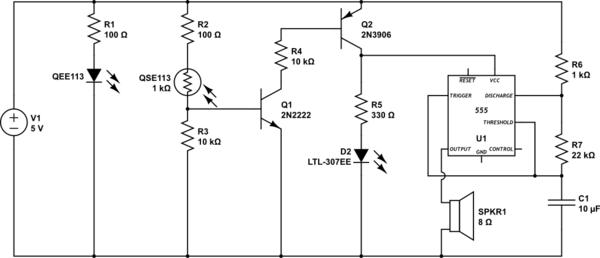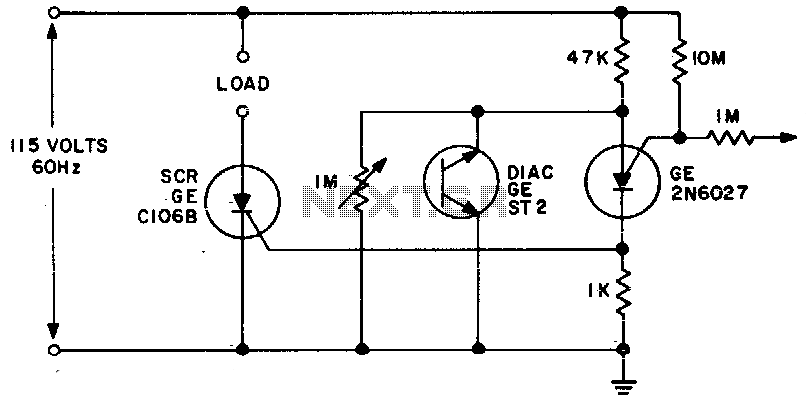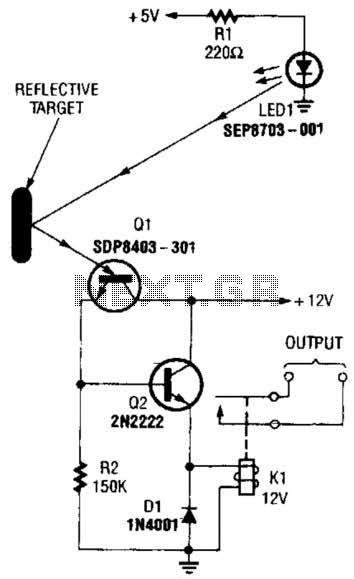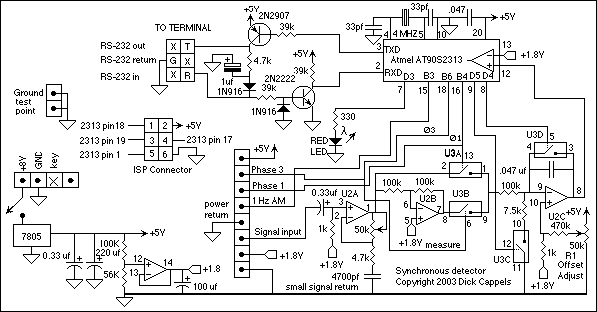
lie detector
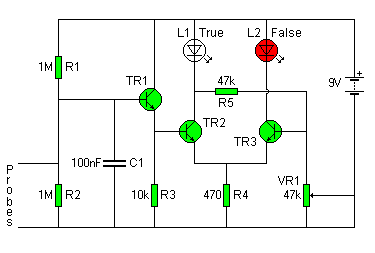
The circuit diagram of the Lie Detector consists of three transistors (TR1 to TR3), a capacitor (C1), two LEDs (L1 & L2), five resistors (R1 to R5), and a variable resistor (VR1). Suitable transistors include BC547, BC548, or BC549, or any other small NPN transistor. The Lie Detector operates on the principle that a person's skin resistance changes with perspiration, which occurs when they are lying. Dry skin typically has a resistance of approximately 1 million ohms, while moist skin can have a resistance reduced by a factor of ten or more. Resistors R1 and R2 form a voltage divider with values of 1,000,000 ohms (1 megohm), resulting in the voltage at the upper probe wire being half the battery voltage (around 4.5 volts). When a person holds the lie detector probe wires, their skin resistance alters the voltage at the upper probe wire. This resistance is in parallel with R2, and since it is likely to be similar to or smaller than R2, the voltage at the probe wire decreases as skin resistance decreases. TR1 and R3 create a buffer circuit known as an emitter follower. The emitter voltage of TR1 tracks the probe wire voltage, allowing it to drive transistor TR2. Transistors TR1 and TR2 function as a voltage comparator. If the voltage at the base of TR2 exceeds that at the base of TR3, the green LED (L1) illuminates. Conversely, if the voltage at the base of TR3 is higher, the red LED (L2) lights up. To test the Lie Detector, hold the probe wire ends and adjust VR1 until the green LED is barely on and the red LED is off. This indicates that the voltage at the base of TR2 is just greater than that at the base of TR3. By moistening fingers and holding the probes, the skin resistance decreases, leading to a drop in the voltage at the base of TR2, causing the red LED to illuminate. When testing with dry skin, position the probe wires on the palm, ensuring the metal ends do not touch, and adjust VR1 until the red LED turns off. With a moist palm, the red light should illuminate brightly. The Lie Detector is primarily designed to detect significant lies that provoke sweating due to fear; it may not effectively detect inconsequential or joking lies. The device can also assess the conductivity of the human body by having a group of people form a circle while holding hands, using the lie detector probes to observe how many individuals the current can flow through to light the red LED. It can test the conductivity of various materials, such as metals, plastics, wood, and hair, with a conductive material causing the red LED to illuminate. Additionally, the device can determine if a houseplant requires watering by probing the soil; if the green LED remains lit, the plant needs water, while a red LED indicates sufficient moisture. Lastly, the probes can be used to check if a cake is properly cooked; if the red LED activates, further cooking is necessary.
The Lie Detector circuit integrates several components to achieve its functionality. The three transistors (TR1, TR2, and TR3) are critical for signal processing and comparison. TR1 serves as a buffer, ensuring that the voltage from the probe wire is transmitted effectively to TR2 without significant loss. The voltage divider formed by R1 and R2 is essential for establishing a reference voltage that is responsive to changes in skin resistance. The variable resistor (VR1) allows for fine-tuning the sensitivity of the circuit, enabling the user to calibrate the detector based on individual skin resistance characteristics.
The LEDs (L1 and L2) serve as visual indicators of the circuit's output, providing immediate feedback on the detected voltage levels. The use of a capacitor (C1) may be to filter out noise or stabilize the voltage levels in the circuit, ensuring reliable performance. The design of the circuit allows for a versatile application, not only for lie detection but also for various educational and practical experiments regarding conductivity and moisture levels in different materials.
Overall, the Lie Detector circuit exemplifies a straightforward yet effective application of electronic components to create a device that can measure physiological responses to emotional states, providing insights into human behavior through its operation.The circuit diagram of the Lie Detector is shown above. It consists of three transistors (TR1 to TR3), a capacitor (C1), two lights or LED`s (L1 & L2), five resistors (R1 to R5), and a variable resistor (VR1). Suitable transistors to use are BC547, BC548 or BC549, or any other small NPN transistor. The Lie Detector circuit works based on the fact that a person`s skin resistance changes when they sweat (sweating because they`re lying). Dry skin has a resistance of about 1 million ohms, whereas the resistance of moist skin is reduced by a factor of ten or more. Resistors R1 and R2 form a voltage divider. They have resistance`s of 1 000 000 ohms (1 meg ohms) and, because their values are equal, the voltage at the upper probe wire is half the battery voltage (about 4.
5 volts). A person holding the lie detector probe wires will change the voltage at the upper probe wire depending on their skin resistance. The skin resistance is in parallel with R2 and, because it is likely to be similar to or smaller than R2, the voltage at the probe wire will fall as skin resistance falls.
TR1 and R3 form a buffer circuit (called an emitter-follower). The voltage at the emitter of TR1 follows the voltage at the probe wire and is now able to drive transistor TR2. Transistors TR1 and TR2 act as a voltage comparator. If the voltage at the base of TR2 is higher than at the base of TR3 then the green LED (L1) will come on.
If the reverse is true then the red LED (L2) will light. To test the Lie Detector hold the ends of the probe wires (the conductors). Adjust VR1 until the green LED is just on and the red LED is just off. This is the point at which the voltage at the base of TR2 is just greater than at the base of TR3. Now use moist fingers to hold the probes. This lowers the skin resistance and causes the voltage at the base of TR2 to fall. The voltage at the base of TR3 is now greater and the red LED comes on. Touch the two probe wires against the palm of your (dry) hand, such that the metal ends are a couple of centimeters apart (the metal ends must not touch each other). Adjust the tuning control (VR1) until the red light (FALSE) just goes out. The Lie Detector is now tuned for your skin. If you lick your palm and touch the wires against it again, the red light should come on brightly. You should now understand how to use the Lie Detector to detect a real lie. Touch the two probe wires against the palm of the subject`s hand and adjust the tuning control as before until the red light just goes out.
When the subject tells a lie, and begins to sweat, the red light will get brighter. It must be emphasized that the Lie Detector won`t detect every lie, as it is really only a sweat detector. It only detects lies that have consequences to being told, lies that cause the subject to sweat (with fear).
Pretend or `joke` lies won`t have any effect. Use lie detector to test the conductivity of the human body. Get a group of people to hold hands in a circle with the two probes of the lie detector as part of the circle. See how many bodies the current will flow through to make the red LED light. Testing the conductivity of objects. For example, metals, plastics, wood, hair, the lead of a pencil. If a material is conductive then touching the probe wires against it will make the red LED light. Determining whether a houseplant needs watering. Touch the probe wires against the soil. If the green LED stays on, the plant needs watering. If the red LED comes on, the soil is sufficiently moist. Determining whether a cake is cooked. Press the probe wires into the surface of the cake. If the red LED comes on then the cake is still moist and needs further cooking 🔗 External reference
The Lie Detector circuit integrates several components to achieve its functionality. The three transistors (TR1, TR2, and TR3) are critical for signal processing and comparison. TR1 serves as a buffer, ensuring that the voltage from the probe wire is transmitted effectively to TR2 without significant loss. The voltage divider formed by R1 and R2 is essential for establishing a reference voltage that is responsive to changes in skin resistance. The variable resistor (VR1) allows for fine-tuning the sensitivity of the circuit, enabling the user to calibrate the detector based on individual skin resistance characteristics.
The LEDs (L1 and L2) serve as visual indicators of the circuit's output, providing immediate feedback on the detected voltage levels. The use of a capacitor (C1) may be to filter out noise or stabilize the voltage levels in the circuit, ensuring reliable performance. The design of the circuit allows for a versatile application, not only for lie detection but also for various educational and practical experiments regarding conductivity and moisture levels in different materials.
Overall, the Lie Detector circuit exemplifies a straightforward yet effective application of electronic components to create a device that can measure physiological responses to emotional states, providing insights into human behavior through its operation.The circuit diagram of the Lie Detector is shown above. It consists of three transistors (TR1 to TR3), a capacitor (C1), two lights or LED`s (L1 & L2), five resistors (R1 to R5), and a variable resistor (VR1). Suitable transistors to use are BC547, BC548 or BC549, or any other small NPN transistor. The Lie Detector circuit works based on the fact that a person`s skin resistance changes when they sweat (sweating because they`re lying). Dry skin has a resistance of about 1 million ohms, whereas the resistance of moist skin is reduced by a factor of ten or more. Resistors R1 and R2 form a voltage divider. They have resistance`s of 1 000 000 ohms (1 meg ohms) and, because their values are equal, the voltage at the upper probe wire is half the battery voltage (about 4.
5 volts). A person holding the lie detector probe wires will change the voltage at the upper probe wire depending on their skin resistance. The skin resistance is in parallel with R2 and, because it is likely to be similar to or smaller than R2, the voltage at the probe wire will fall as skin resistance falls.
TR1 and R3 form a buffer circuit (called an emitter-follower). The voltage at the emitter of TR1 follows the voltage at the probe wire and is now able to drive transistor TR2. Transistors TR1 and TR2 act as a voltage comparator. If the voltage at the base of TR2 is higher than at the base of TR3 then the green LED (L1) will come on.
If the reverse is true then the red LED (L2) will light. To test the Lie Detector hold the ends of the probe wires (the conductors). Adjust VR1 until the green LED is just on and the red LED is just off. This is the point at which the voltage at the base of TR2 is just greater than at the base of TR3. Now use moist fingers to hold the probes. This lowers the skin resistance and causes the voltage at the base of TR2 to fall. The voltage at the base of TR3 is now greater and the red LED comes on. Touch the two probe wires against the palm of your (dry) hand, such that the metal ends are a couple of centimeters apart (the metal ends must not touch each other). Adjust the tuning control (VR1) until the red light (FALSE) just goes out. The Lie Detector is now tuned for your skin. If you lick your palm and touch the wires against it again, the red light should come on brightly. You should now understand how to use the Lie Detector to detect a real lie. Touch the two probe wires against the palm of the subject`s hand and adjust the tuning control as before until the red light just goes out.
When the subject tells a lie, and begins to sweat, the red light will get brighter. It must be emphasized that the Lie Detector won`t detect every lie, as it is really only a sweat detector. It only detects lies that have consequences to being told, lies that cause the subject to sweat (with fear).
Pretend or `joke` lies won`t have any effect. Use lie detector to test the conductivity of the human body. Get a group of people to hold hands in a circle with the two probes of the lie detector as part of the circle. See how many bodies the current will flow through to make the red LED light. Testing the conductivity of objects. For example, metals, plastics, wood, hair, the lead of a pencil. If a material is conductive then touching the probe wires against it will make the red LED light. Determining whether a houseplant needs watering. Touch the probe wires against the soil. If the green LED stays on, the plant needs watering. If the red LED comes on, the soil is sufficiently moist. Determining whether a cake is cooked. Press the probe wires into the surface of the cake. If the red LED comes on then the cake is still moist and needs further cooking 🔗 External reference
